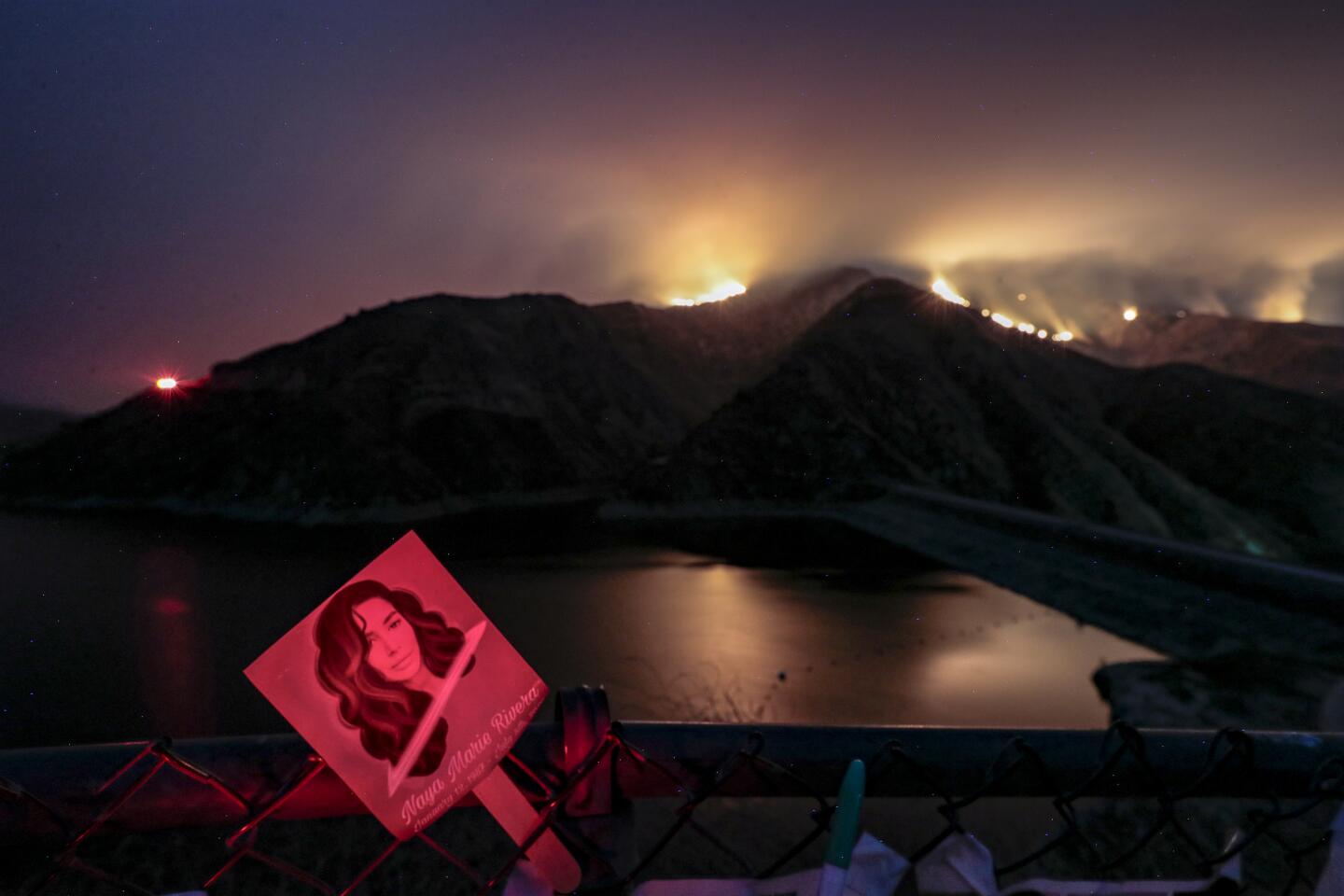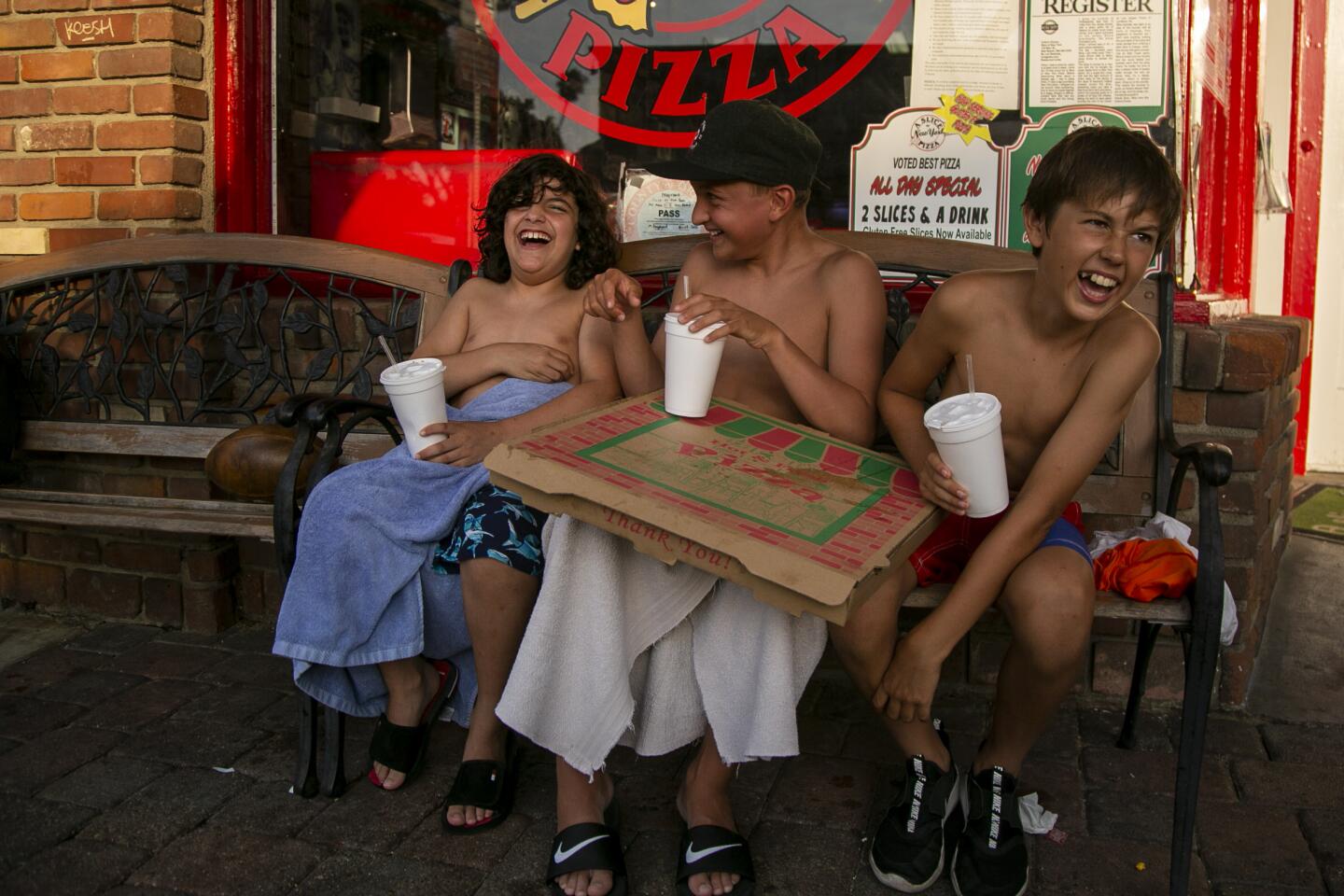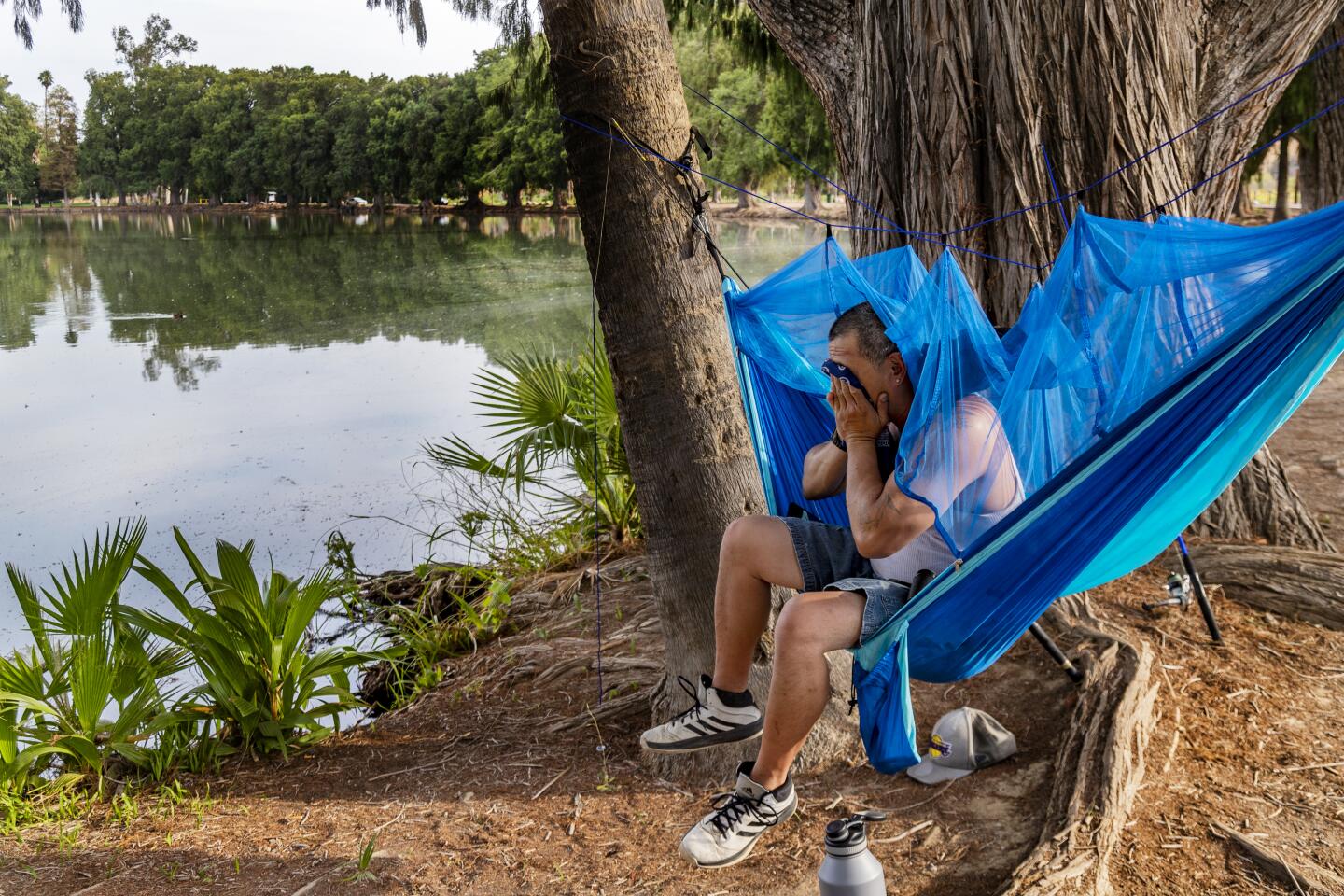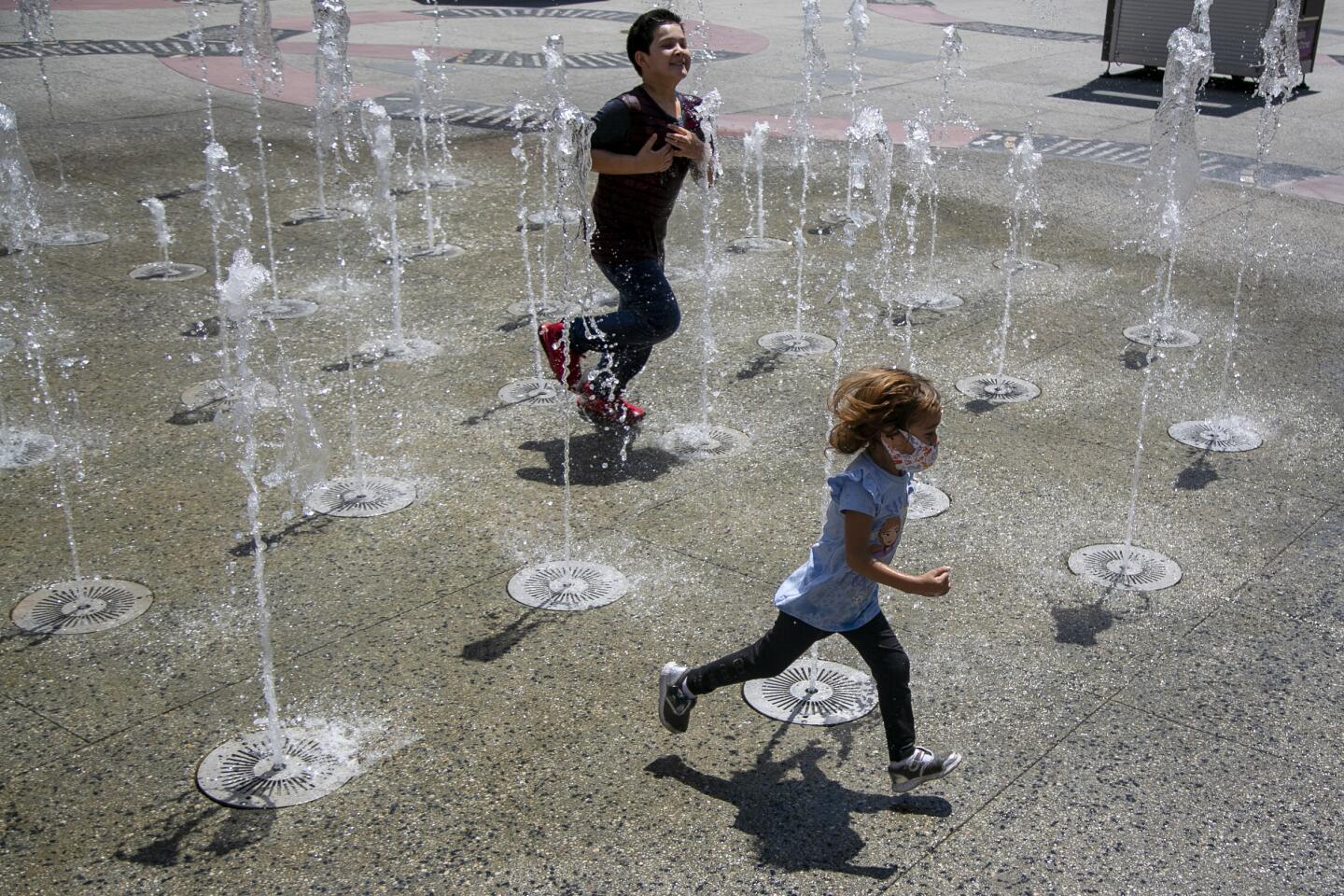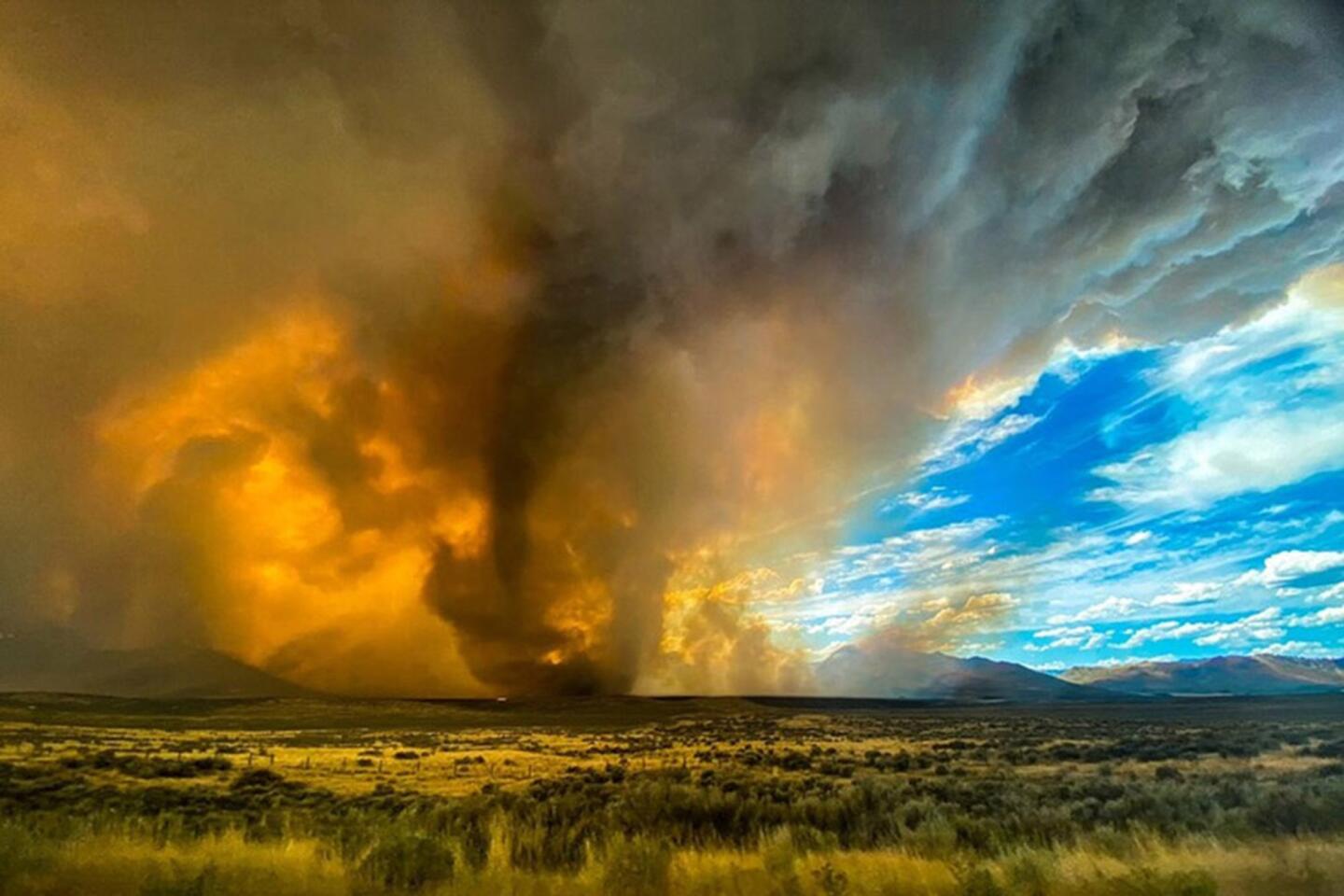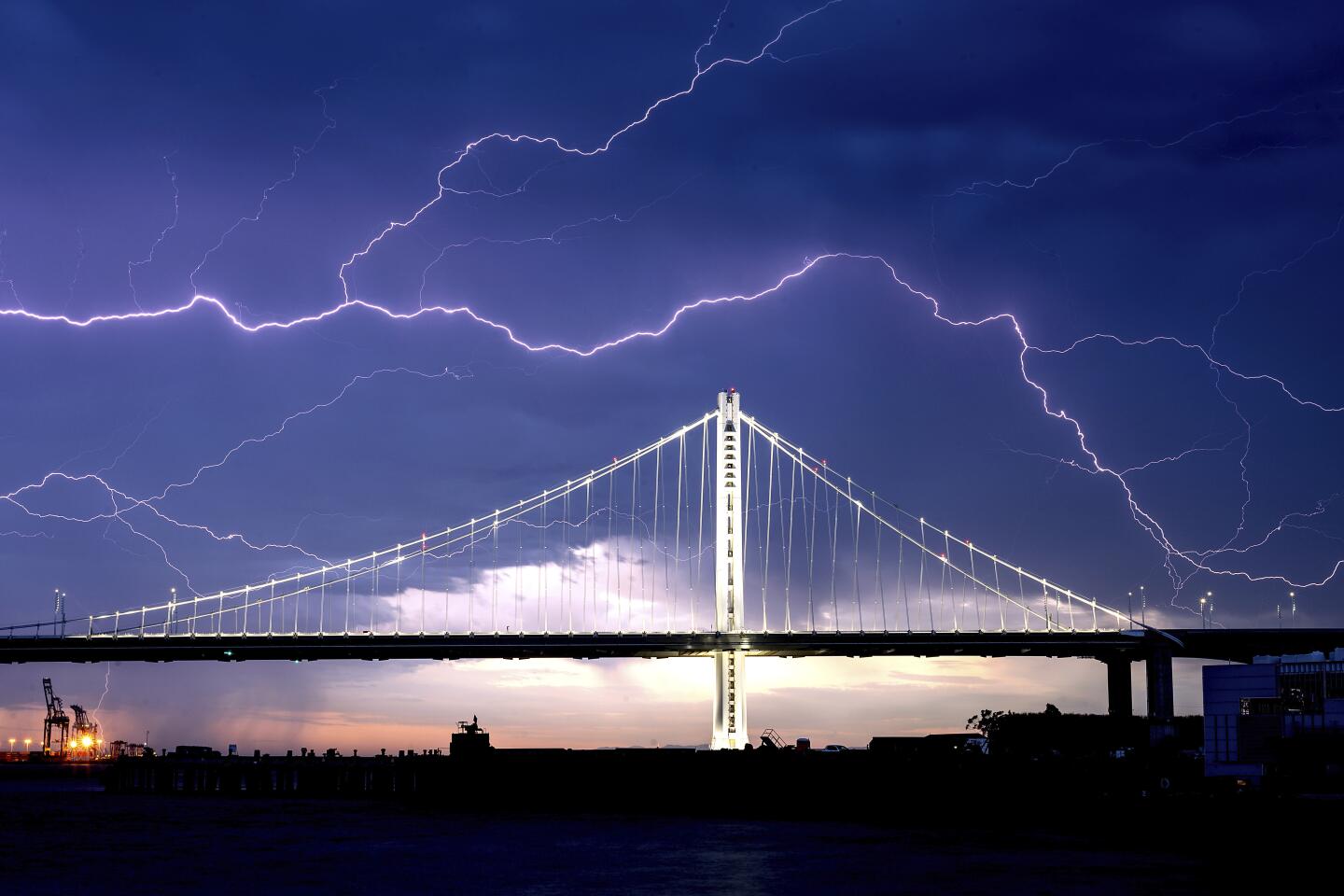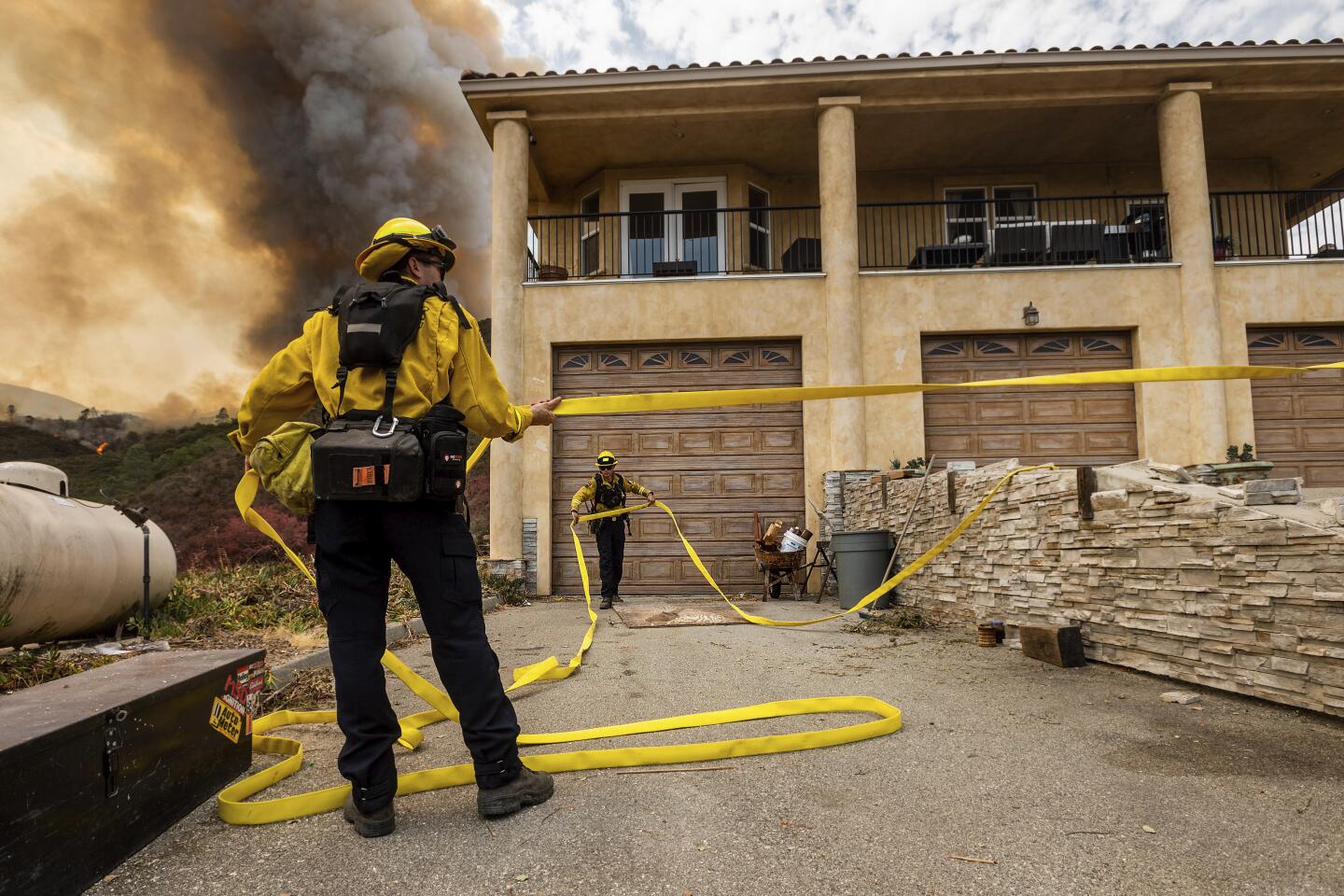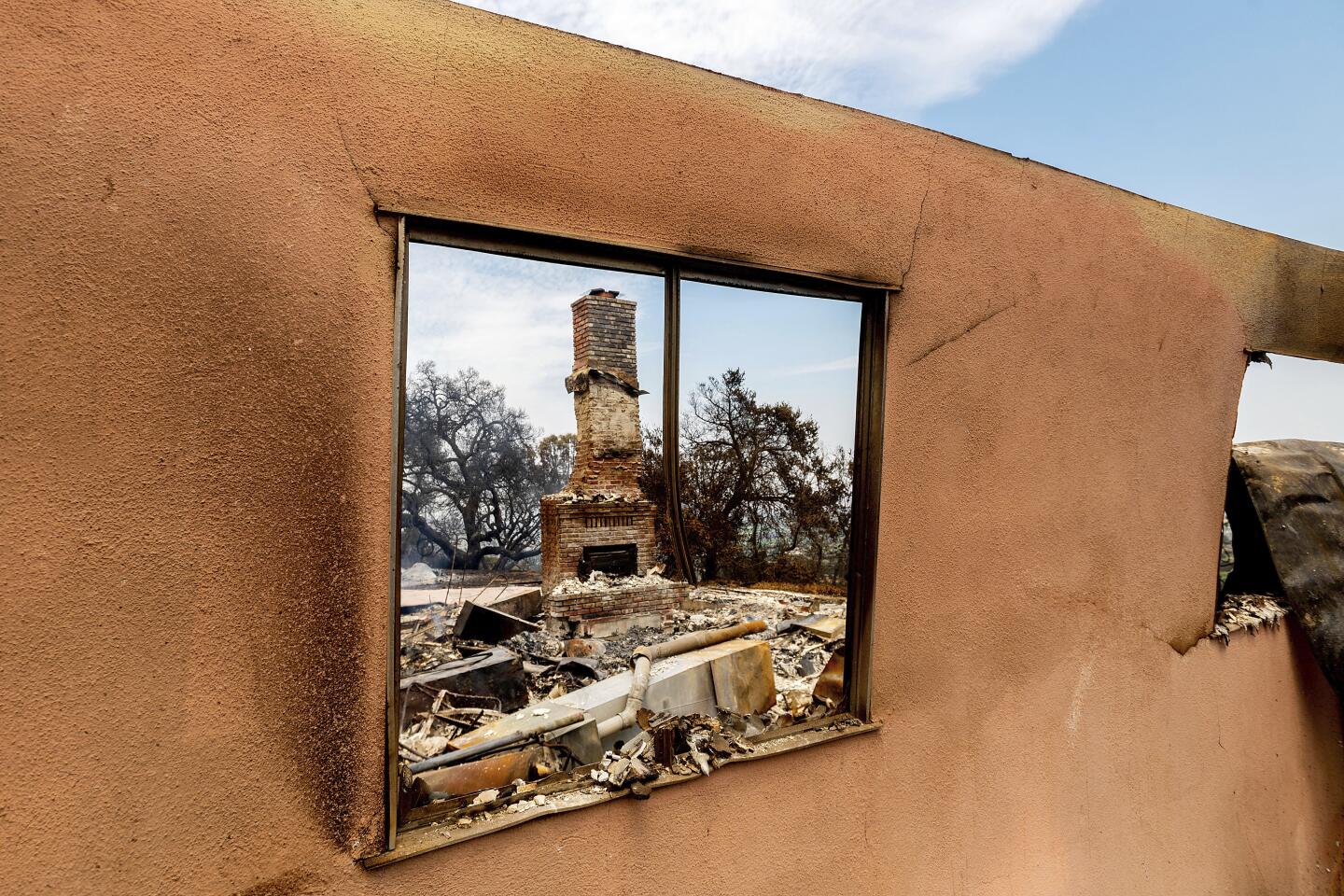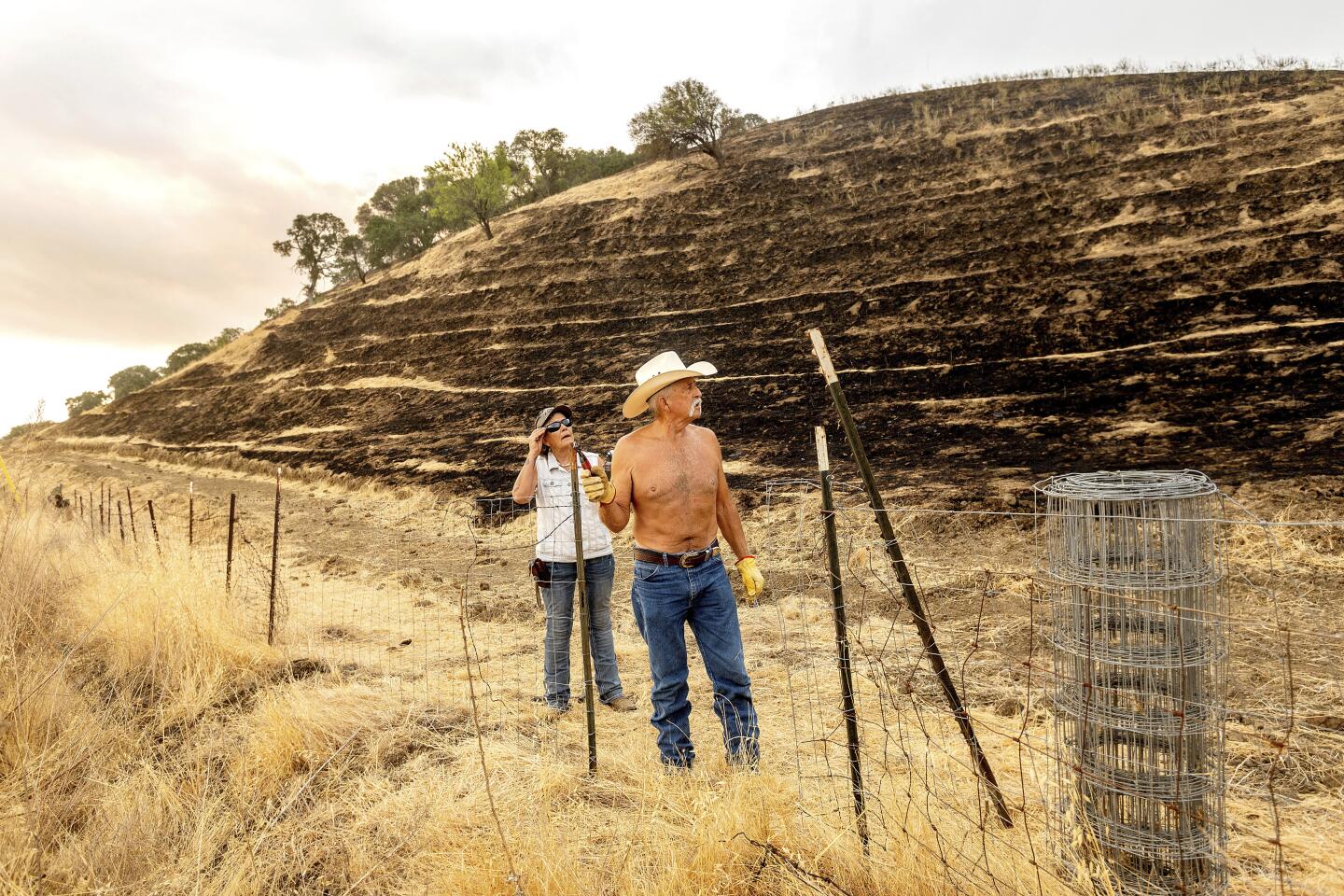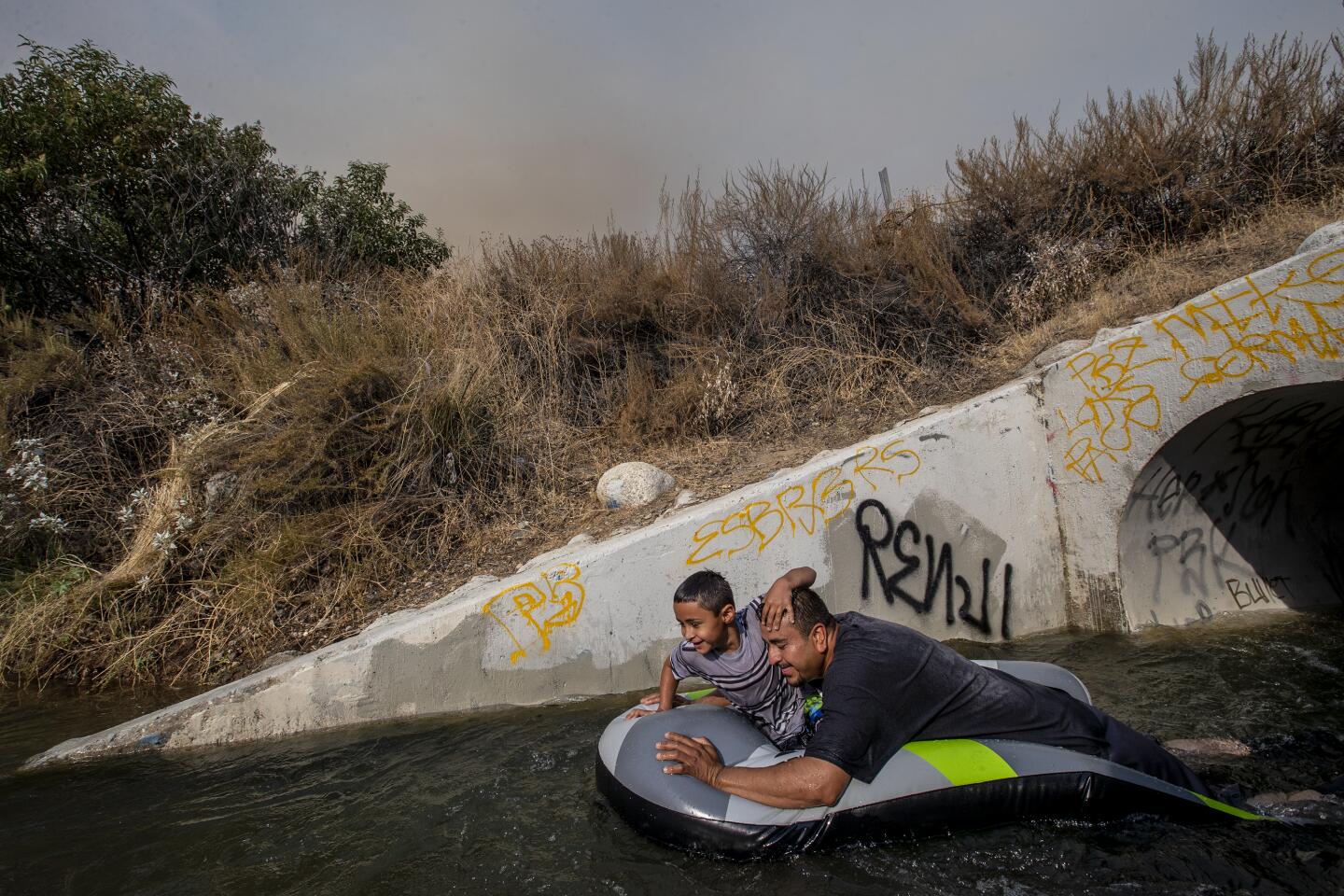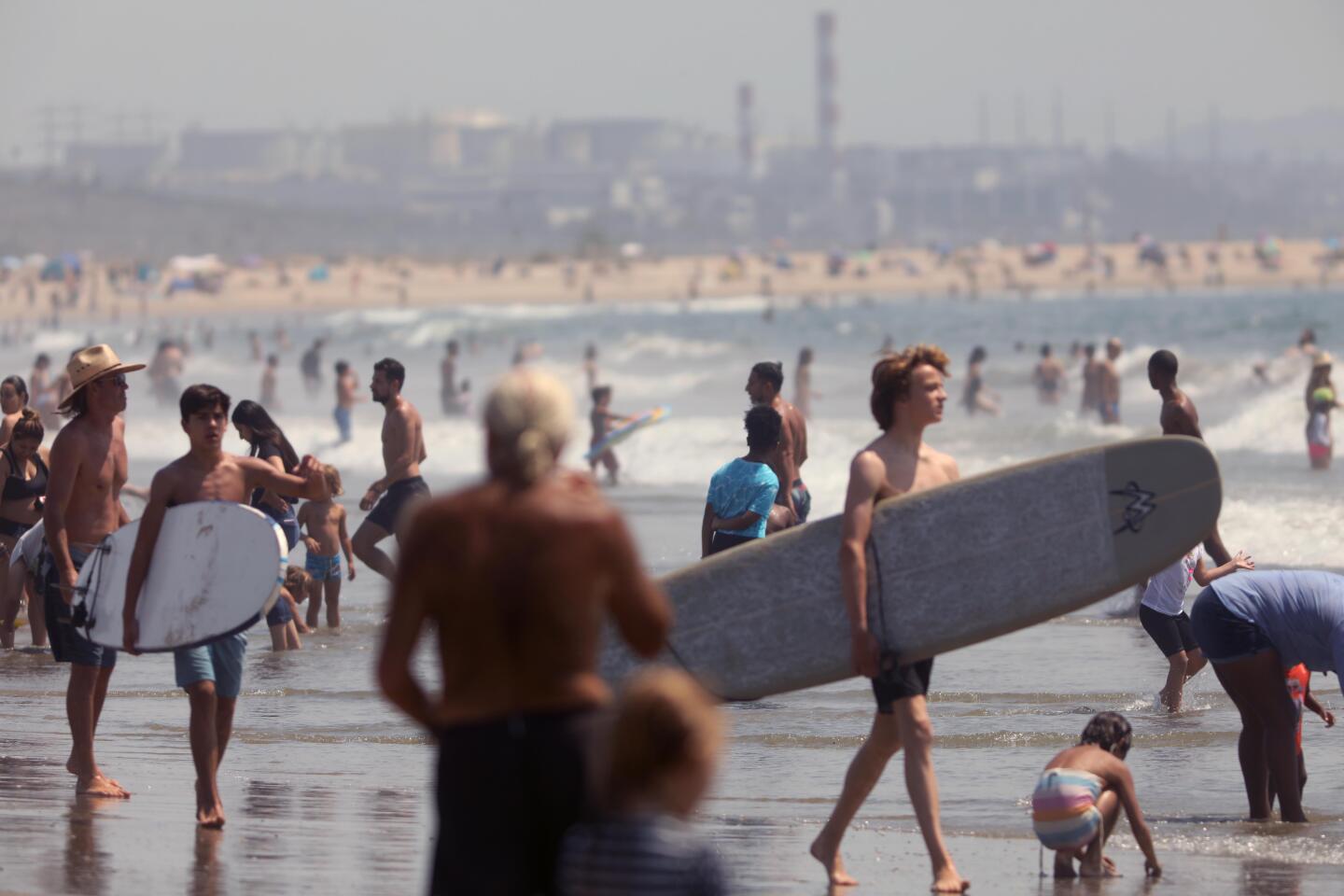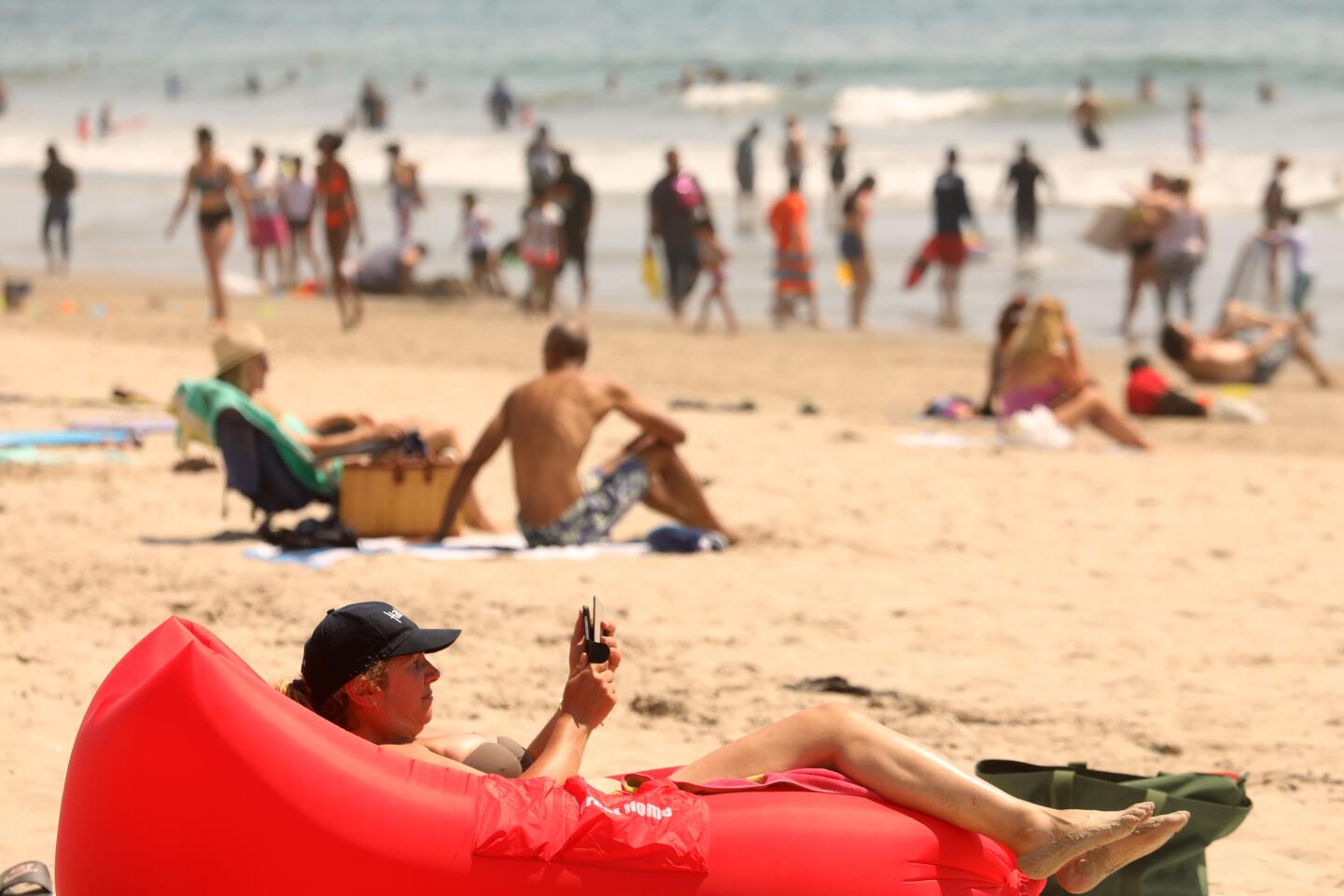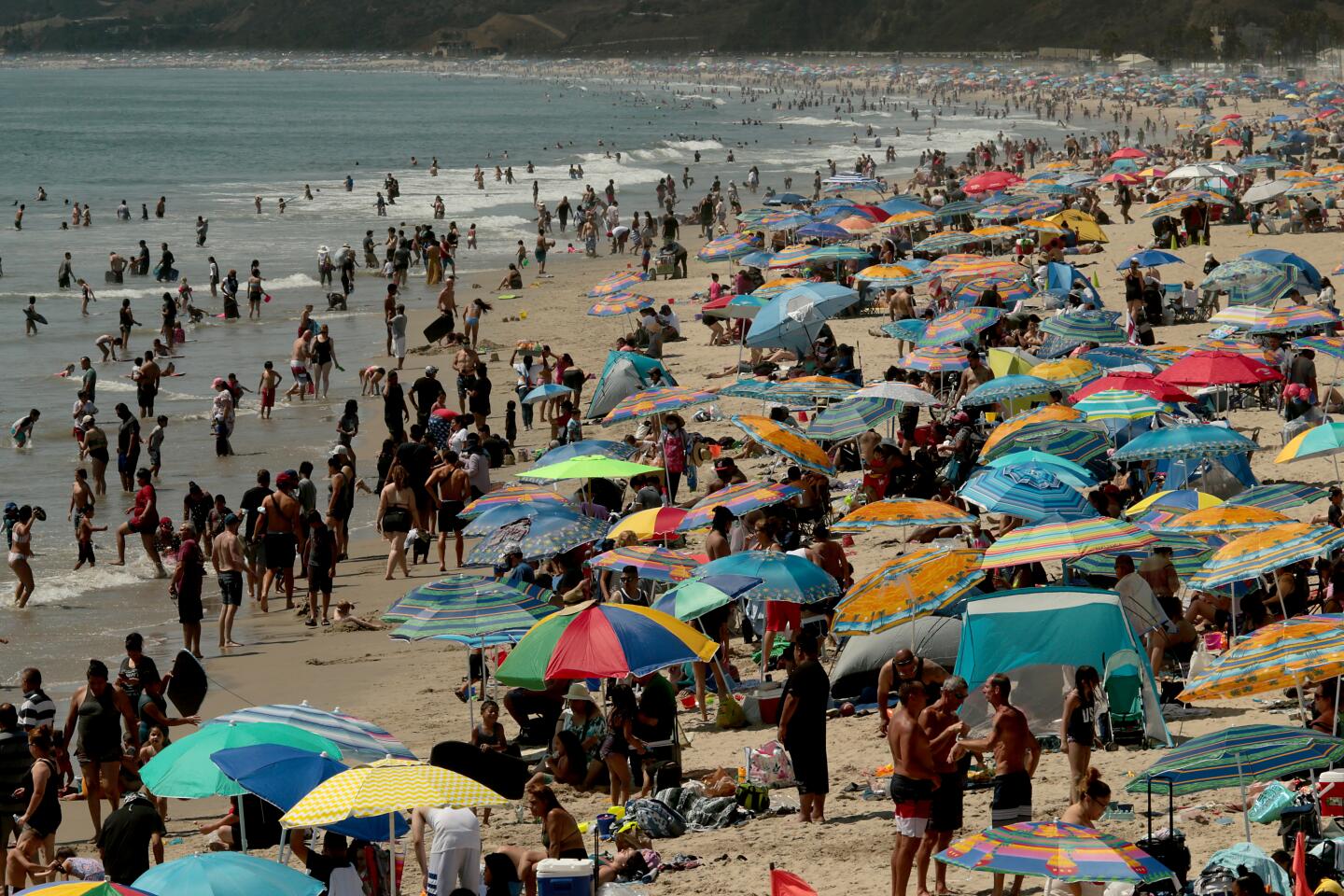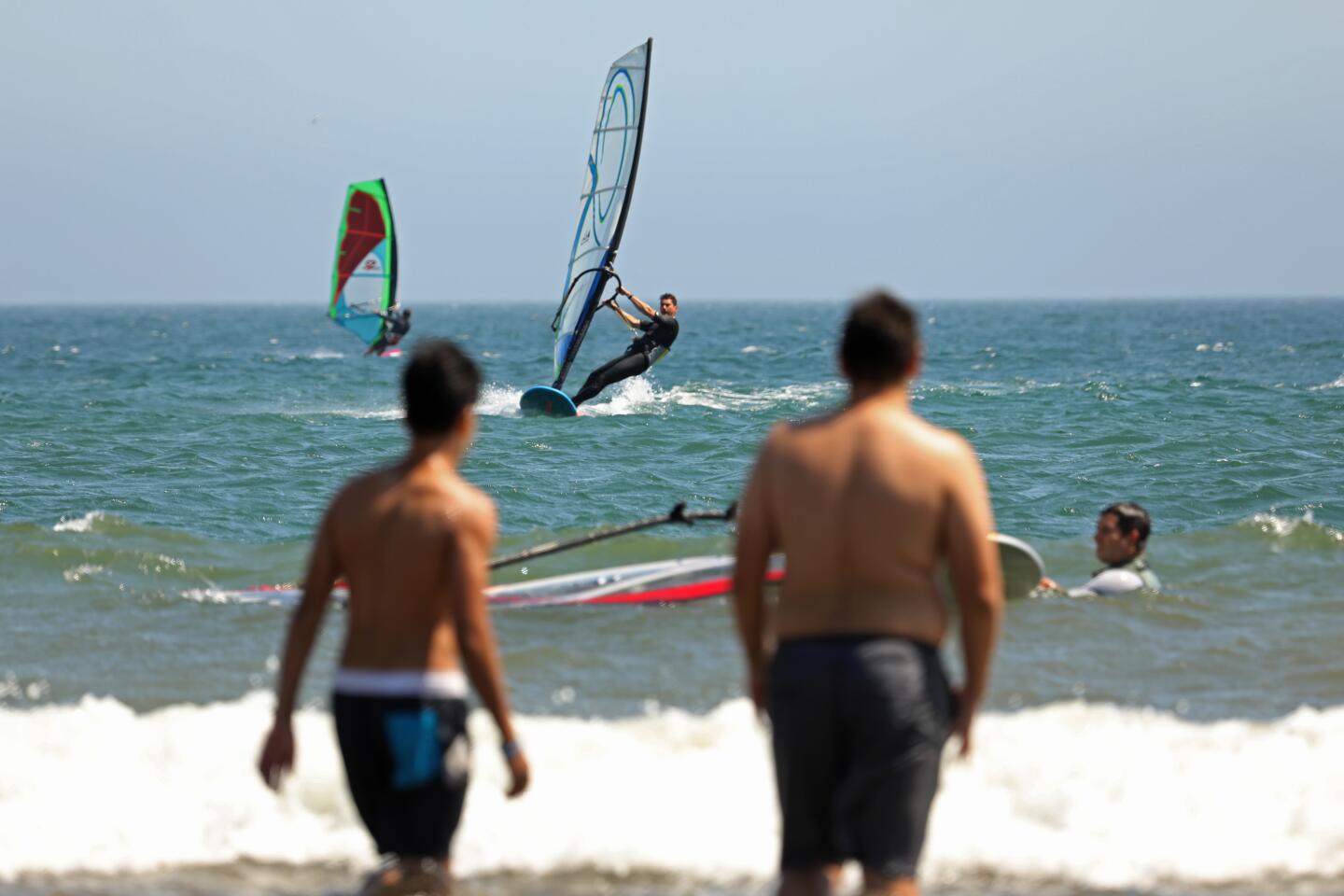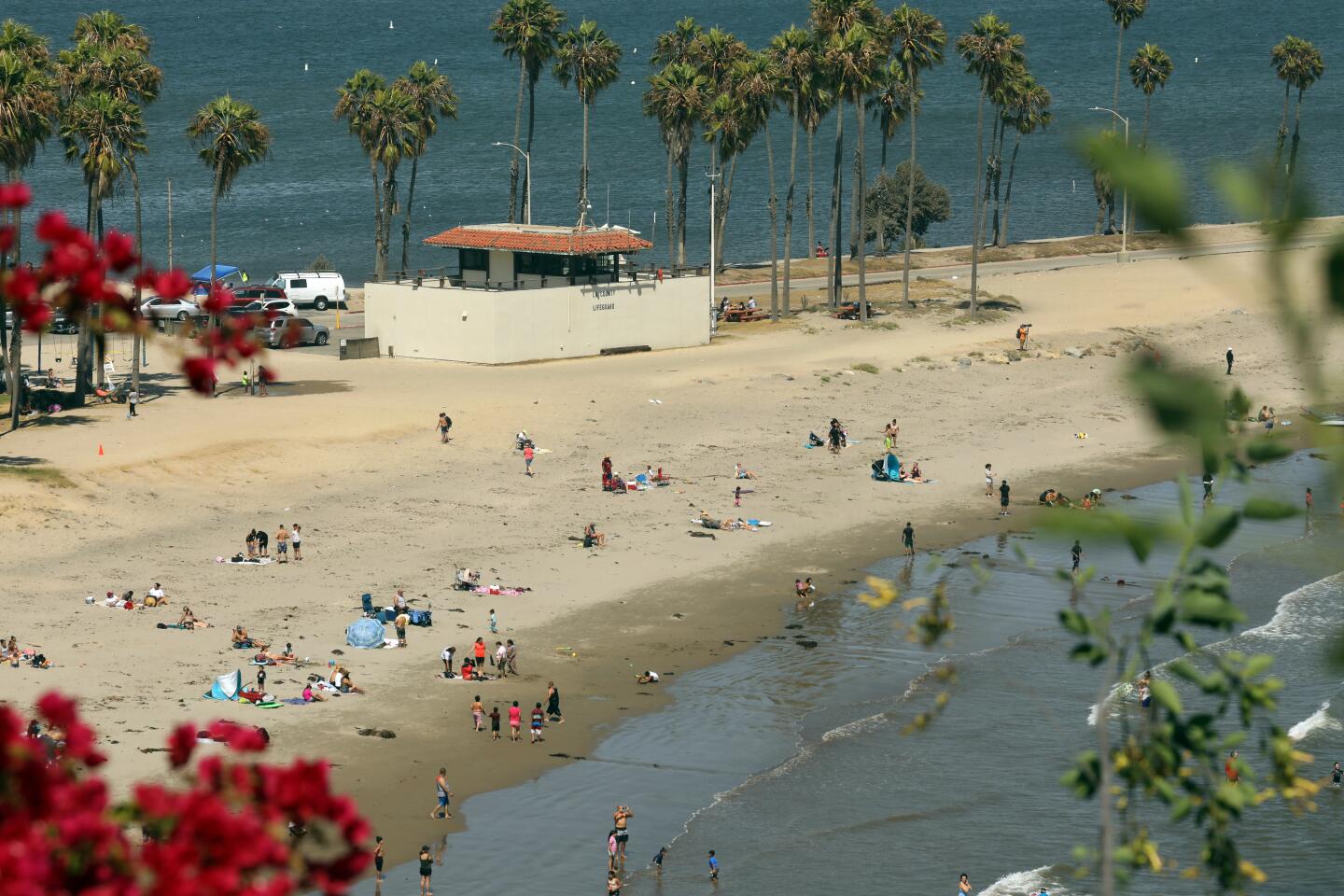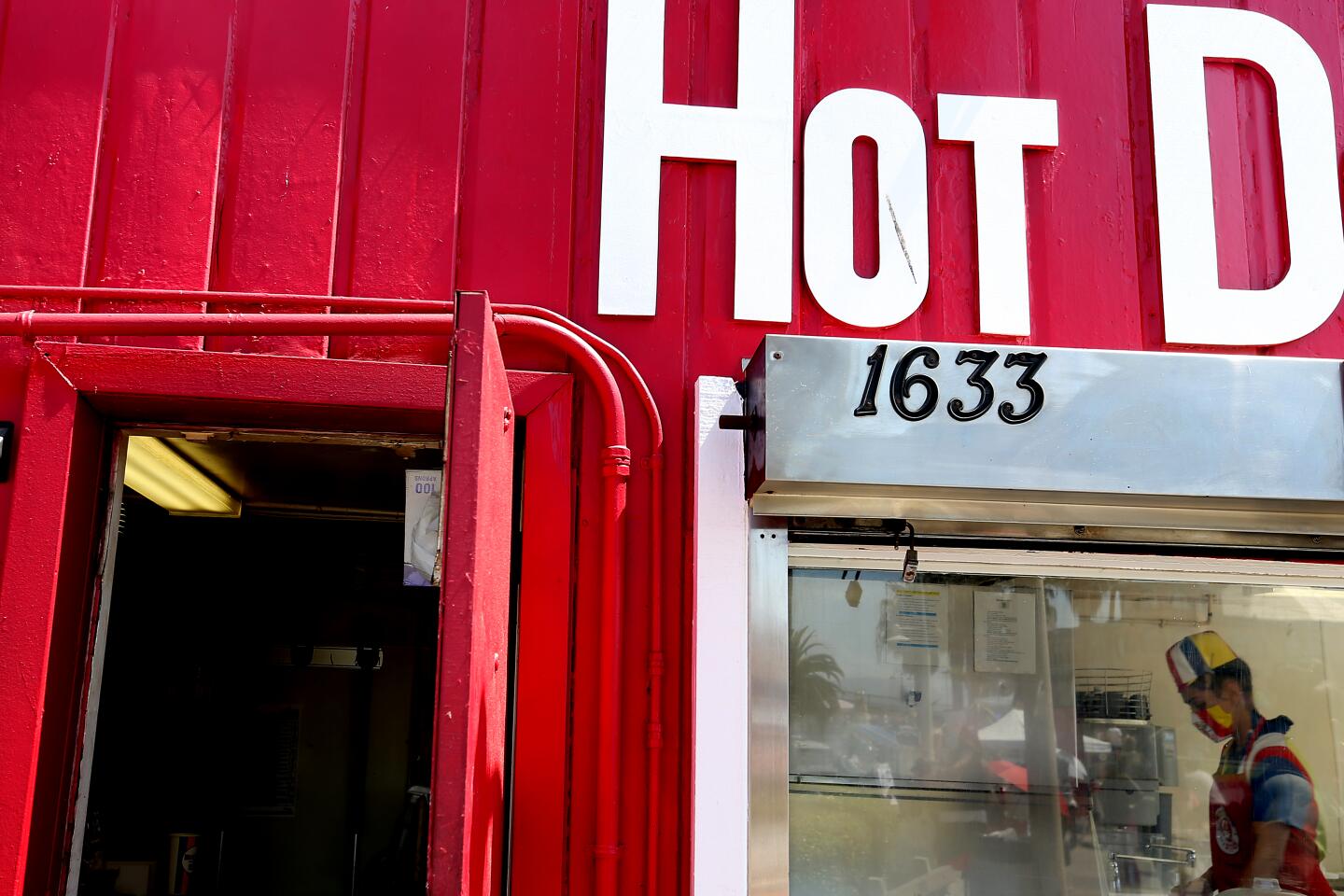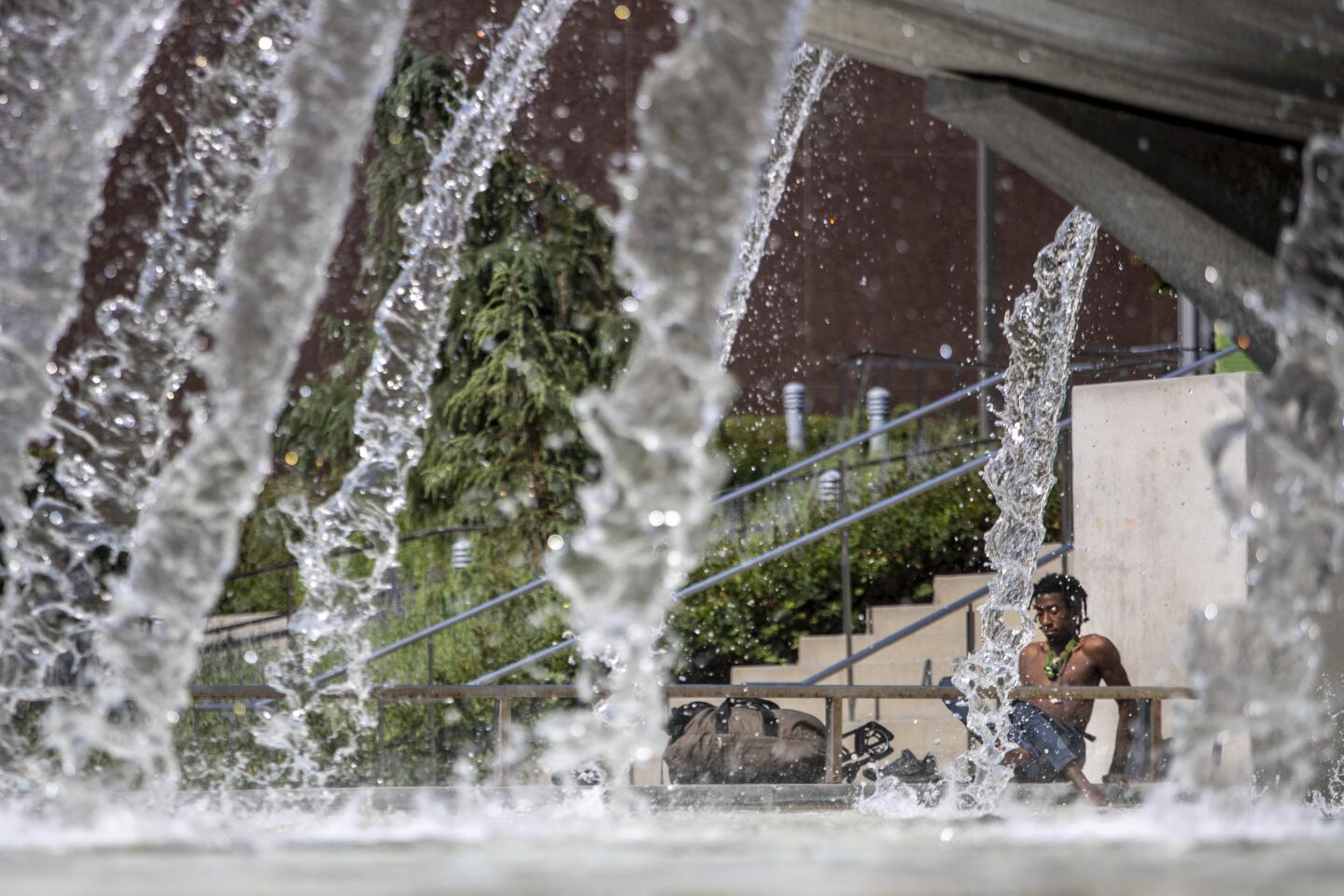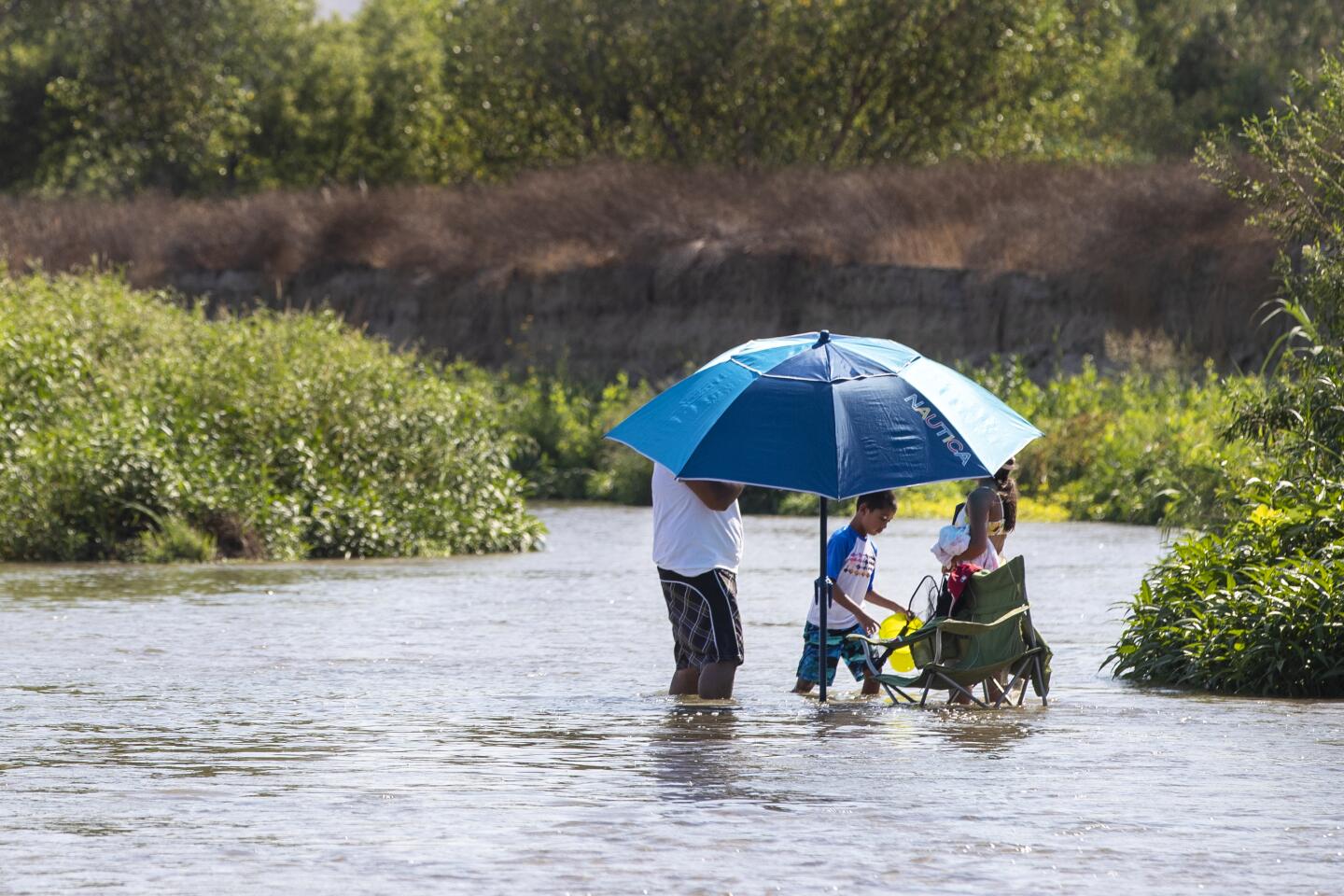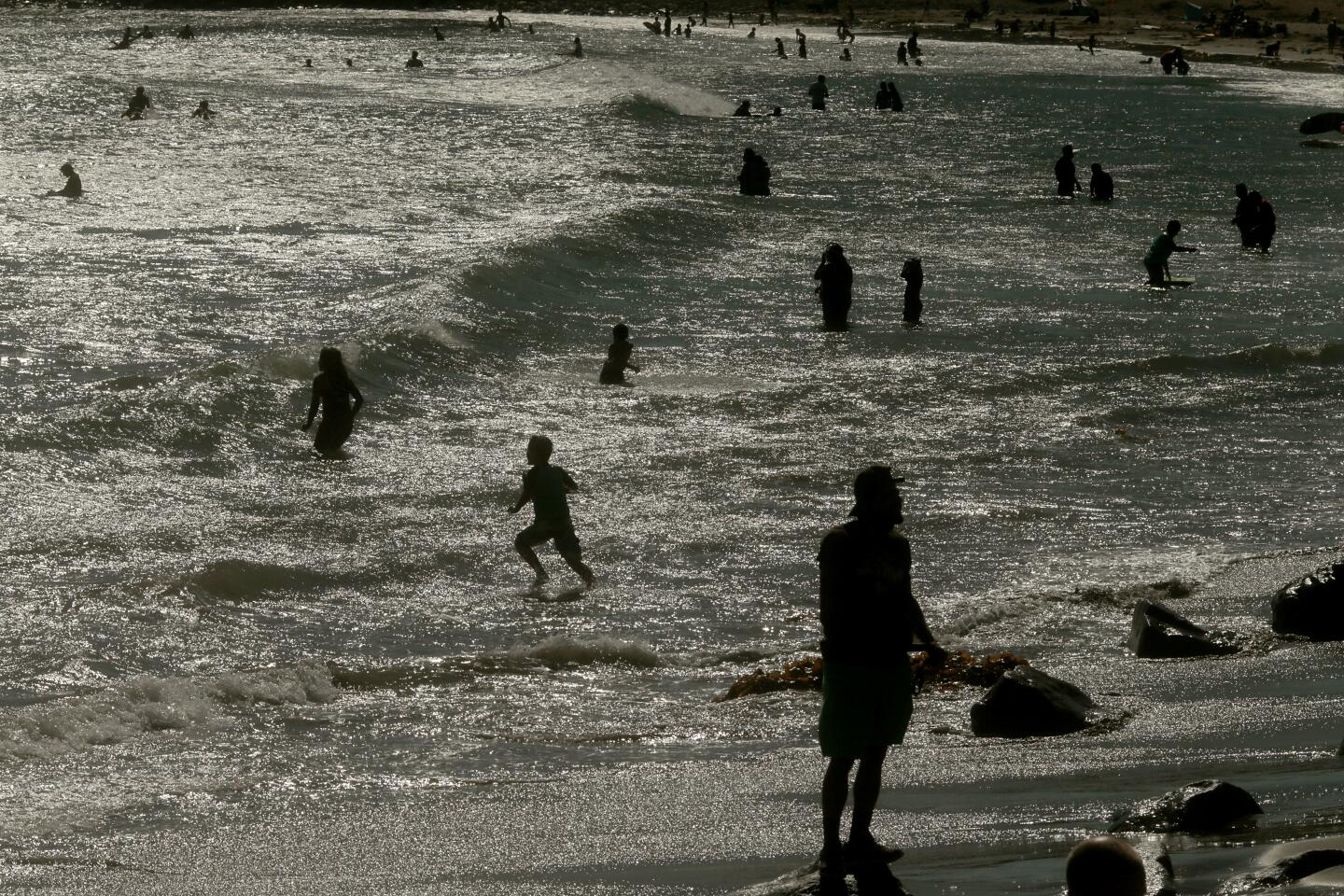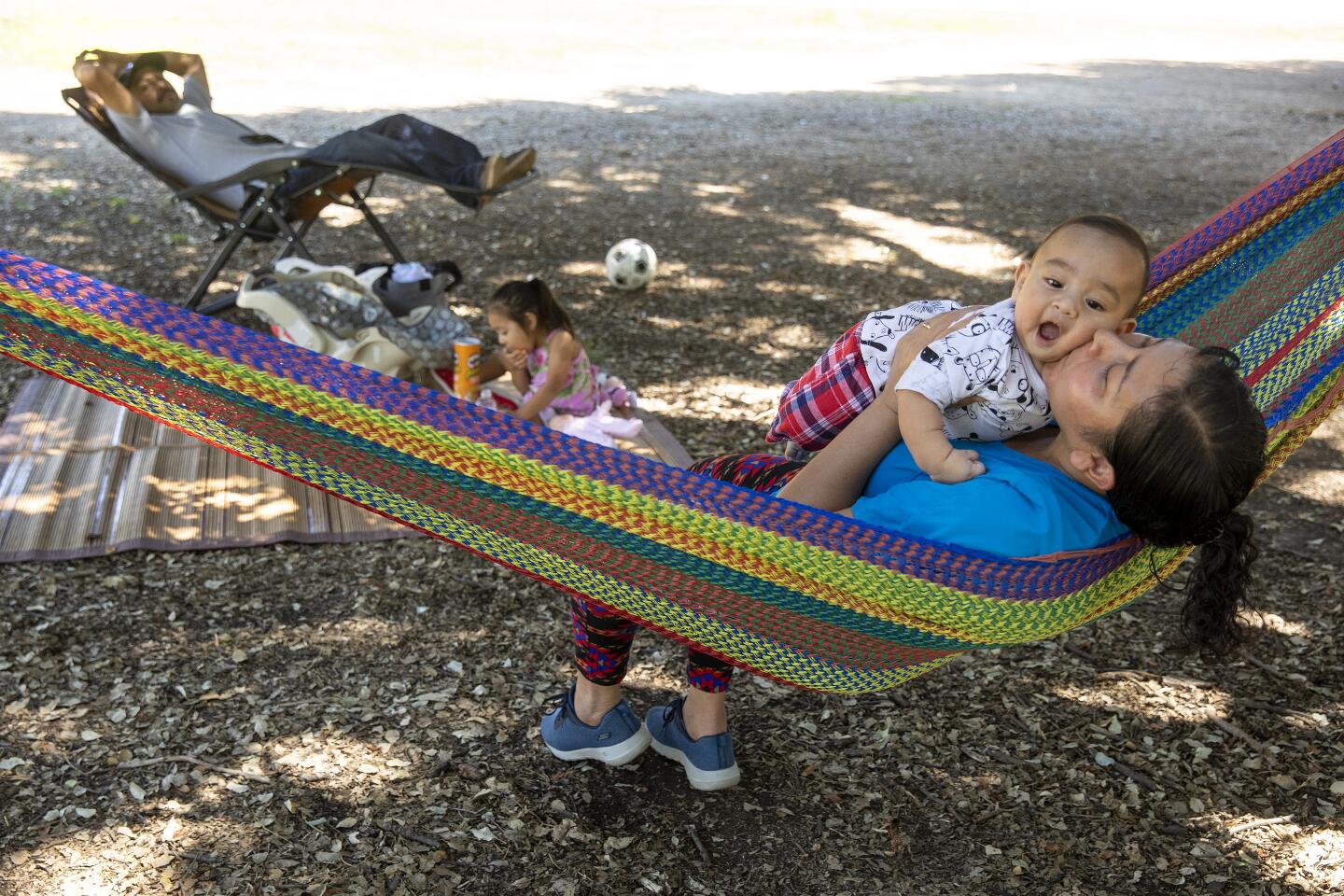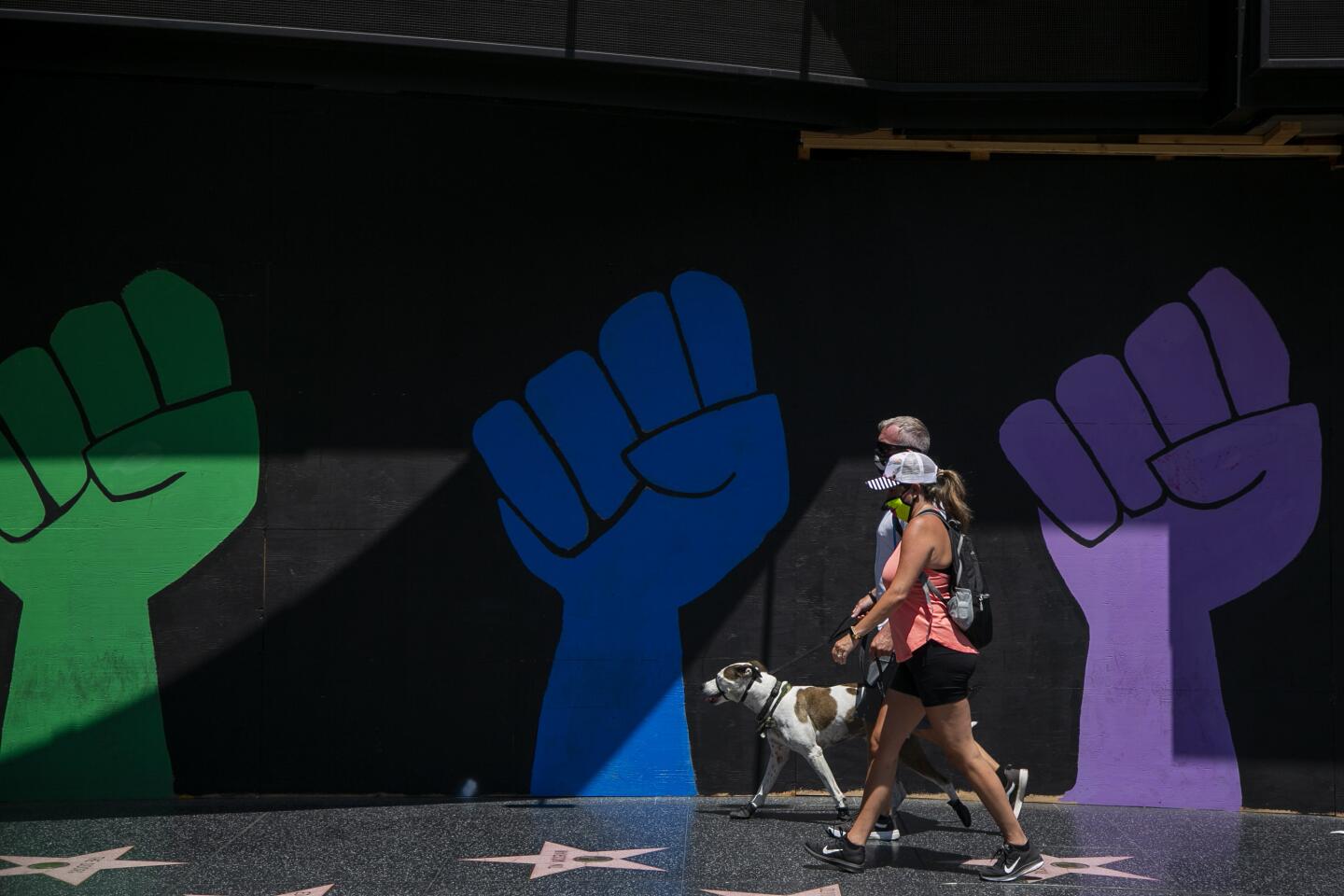Coronavirus complicates California’s worst power shortage in two decades
- Share via
A late-summer heat wave in Southern California typically sends people fleeing to movie theaters, shopping malls and crowded beaches in search of a cool respite.
But the coronavirus pandemic has forced the closure of places where people once gathered, upending those routines.
So as temperatures soared Friday, many people instead stayed at home with their air conditioners blasting. Even though many offices and businesses were closed due to the pandemic, that intense demand — along with other factors including a dearth of power coming in from other states — was enough to create the most serious statewide energy shortage in nearly 20 years, officials said. On Saturday night, another round of temporary blackouts was ordered in parts of the state.
The California Independent System Operator, the body that runs the electric grid for most of California, declared a statewide Stage 3 emergency Friday evening and ordered utilities to shed about 1,000 megawatts, prompting rolling blackouts across the state. A single megawatt powers about 750 homes, spokeswoman Anne Gonzales said.
It was the first time since 2001 that state electric grid operators have had to take the drastic step.
The precise causes of the power shortage remained somewhat of a mystery on Saturday. The rolling blackout of two decades ago occurred after deregulation of the energy markets, which led to manipulations for profit by companies like Enron. One question going forward will be what role market forces or planning by regulators played in the shortage.
At the same time, California has seen a shift in its power supply over the last two decades, relying more on solar and gradually less on fossil fuels.
The blackouts, which typically lasted an hour or two, cut power to more than 130,000 Southern California Edison customers and approximately 220,000 Pacific Gas & Electric customers in Northern California’s El Dorado, Napa, Marin, San Mateo and Sonoma counties.
In addition to the spike in demand, the sheer breadth of the heat wave, which covers a huge swath of the western United States, was a key culprit. The record heat caused electricity shortages in many neighboring states, preventing them from exporting excess power to California, officials said.
“Because we’re all interconnected, when there’s a need in California, power will flow into the state from out-of-state generation, and that helps meet the demand,” said Robert Villegas, spokesman for Southern California Edison. “But when other states are also experiencing high heat conditions and extensive demand on their systems, a lot of that power would stay closer to where it’s produced.”
In some ways, the power shortage was counterintuitive given how many offices and businesses are closed due to the pandemic.
But even during these conditions, overall electricity demand has followed the usual pattern: climbing during the workweek and trailing off over the weekend, according to Gonzales. Officials initially thought this would prevent further interruptions over the weekend, but Saturday night, both Pacific Gas & Electric and San Diego Gas & Electric announced more blackouts. Southern California Edison also warned of more blackouts.
Utility companies across the state were urging customers to help conserve energy by doing things like setting the thermostat no lower than 78 degrees and unplugging unused appliances.
“I always tell people that everything your mother told you when you were little, it was in fact true,” Villegas said. “Don’t leave the refrigerator door open while you’re thinking about what to get from inside. Don’t leave the back door open because it does let the heat in. Turn off lights when you’re not using them. … The simple things are really where it’s at here.”
The COVID-19 pandemic has also caused cities and counties across the state to rethink how they operate cooling centers, another crucial component of how the region protects its residents during heat waves. The centers often attract the elderly and people with underlying health conditions that make them particularly susceptible to heat as well as illness.
A notice on Kern County’s website laying out new precautions says people seeking refuge will be screened for fevers and other COVID-19 symptoms before entering a cooling center and those displaying signs of the disease will not be allowed inside. Once inside, people will be asked to stay six feet apart and will be “encouraged” to wear a face covering, the website says.
The city of Los Angeles, which opened cooling centers Friday, is also screening for COVID symptoms at the door and then requiring people to stay masked and separated once inside. Staff are wearing personal protective equipment, including masks and gloves.
“Normally our facilities can hold a lot more people, but due to COVID the capacity is diminished,” said Emergency Management Coordinator Sonya Young Jimenez. As of Saturday afternoon, Jimenez said she was unaware of anyone having to be turned away because they were suspected of having COVID-19.
At the same time, large brush fires burning in the Angeles National Forest above Lake Hughes and Azusa severely compromised air quality, causing public health officials Saturday to warn people to avoid unnecessary outdoor exposure and putting yet another limit on options to escape the heat.
“I think there’s a variety of factors we all need to be concerned about,” said Margie Otto, spokeswoman for Pasadena Power and Water. “There’s the potential for wildfires, the high heat, energy use and all of the power generation sources.”
The utility received a directive from Cal ISO to shed load at about 7:30 p.m. Friday, followed by another notification a half-hour later that it was no longer necessary, she said. About 1,500 of its 65,000 electrical customers were without power for 30 minutes.
Southern California Edison cut power to roughly 132,000 of its 5 million customers Friday night, each for about an hour, Villegas said. All customers had their power restored by 8 p.m., he said.
“Typically what happens is [the blackouts] will be done in small blocks that include portions of communities, so we don’t shut down a county or something like that,” he said. He said the utility is also careful to avoid cutting off power to critical facilities like hospitals and public safety buildings.
The goal of the controlled shutoffs is to avoid longer and more widespread outages due to equipment failures that can result when high demand overburdens the system, he said. The utility has also deployed emergency management crews throughout its service territory to quickly respond to and repair those types of outages for the duration of the heat wave.
“We totally understand it’s a hardship when you’re without power, especially in this time when options are limited,” Villegas said. “With students being at home now starting school online and people working from home, of course their livelihoods and their education are things that we’re looking at so we’re trying to minimize as best we can interruption to people in their homes.”
Cal ISO also directed San Diego Gas & Electric to implement rotating blackouts Friday night. The utility shut off power to about 58,700 customers in San Diego County and southern Orange County for roughly an hour each, it said.
The Los Angeles Department of Water and Power said its customers were not affected by the statewide blackouts because the department generates, imports and transmits its own electricity and was able to meet the city’s demand.
In fact, the utility, which has never had to implement rolling blackouts due to excess demand, was able to sell 225 megawatts to California ISO between 5 and 9 p.m., spokesman Joe Ramallo said.
Still, he said, the heat strained local power distribution networks, leading to isolated outages unrelated to the statewide rolling blackouts as some equipment became overloaded and failed. About 1,000 of the DWP’s 1.5 million customers were without power as of Saturday morning, most of them in the San Fernando Valley. On Friday night, localized outages were reported in Sunland and Wilmington, Ramallo said.
The problem can be particularly acute during prolonged heat waves like these, when nighttime temperatures don’t drop enough for the electrical equipment to cool down, he said.
“It’s like running your car at 100 mph nonstop and not giving it a break,” Ramallo said. “You’re eventually going to have some problems that pop up, and in this case there will be failed equipment and transformers.”
Officials expressed cautious optimism that they’d be able to get through the next couple days without additional blackouts. The California ISO does not expect to have to order rolling outages for the rest of the weekend, Gonzales said.
“The temperatures are expected to be a bit lower than yesterday and it’s the weekend, so we see a bit less demand,” she said.
More to Read
Sign up for Essential California
The most important California stories and recommendations in your inbox every morning.
You may occasionally receive promotional content from the Los Angeles Times.

